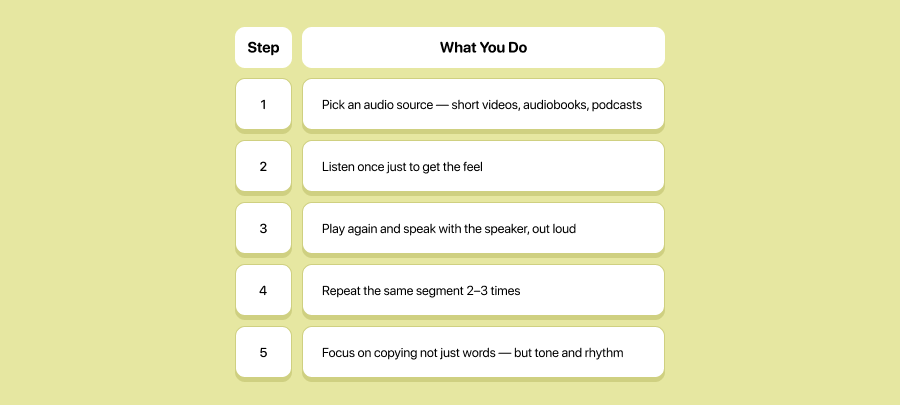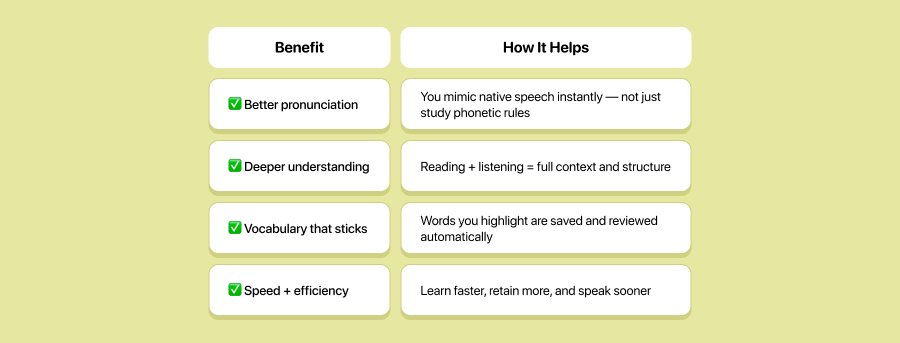You know that awkward moment when you try to speak English, and it just… doesn’t sound quite right? Maybe the words are correct, but your rhythm, stress, or intonation feels off. You’re saying the sentence — but not sounding like a native speaker at all.
If this rings a bell, let us introduce you to a seriously powerful method that even polyglots swear by: the shadowing technique. It’s not magic. It’s muscle memory — and it works.
First Things First: What Is Shadowing?
In its most basic form, shadowing means mimicking someone in real-time. The concept originally came from interpreting and theater training — imagine someone repeating lines just a breath behind the speaker, like a real-time echo.
In fact, professional interpreters sometimes train this way: by listening to a speaker in one language and simultaneously whispering the translation in another. It forces your brain to think fast, speak fast, and act fast, all at once.
Now, take that same concept and apply it to language learning. Instead of translating, you're listening to someone speak (in English, for example) and repeating after them out loud almost immediately, trying to copy their tone, pronunciation, and rhythm as closely as possible.
You’re not pausing. You’re not writing things down. You’re speaking, in sync, even if you don’t understand every word yet.
That’s the core of the shadowing technique in English: don’t study the language. Perform it.
How Does Shadowing Work in Language Learning?
Imagine this: you’re listening to a short English dialogue, maybe something like:
"Hey, how’s it going?"
"Not bad! Just got back from work."
As soon as the speaker says it, you say it too, aloud, with no time to overthink:
“Hey, how’s it going?” (you repeat)“Not bad! Just got back from work.” (you echo it instantly)
At first, you might stumble. Miss a few words, sound weird. That’s normal.
But after a few repetitions, your brain starts picking up the musicality of English — the way words blend, the stress on syllables, the natural flow of speech.
You’re not just learning English. You’re absorbing it.
Here’s a breakdown of how to do shadowing properly:

This isn’t about perfect understanding. It’s about training your mouth and ears to dance together.
Why Does This Actually Work?
Because speaking is a physical skill.
Like singing, dancing, or playing an instrument, you don’t get fluent by studying alone. You get fluent by doing.
Here’s what makes shadowing so effective:
- 💬 Pronunciation practice – You learn to pronounce sounds the way native speakers do, by copying them again and again.
- 🧠 Improved listening – You train your ears to catch the natural speed and connected speech of English.
- 🚀 Faster thinking – No time to overthink = no translation = real-time speaking ability.
- 🗣️ Confidence boost – The more you speak aloud, the less afraid you are of making mistakes.
It’s intense. It’s immersive. And it forces your brain and tongue to work together quickly.
Shadow Reading: A Step in Between
If diving straight into full-speed shadowing feels intimidating, try shadow reading first.
That means repeating along with audio, but with the written text in front of you. It helps you connect how a word looks to how it sounds, especially if you’re a visual learner.
Eventually, you’ll wean off the script and graduate to full-on shadowing, no text needed.
Shadowing Learning in EWA: Shadowing 2.0 with Superpowers
Now here’s the game-changer: EWA’s Shadowing Learning 2.0.
This isn’t just another listening exercise. It’s a full-featured experience where you read, listen, speak, and learn vocabulary — all in real time, in one place.
Here’s how it works:
- You open a book in the EWA app 📖
- At the same time, you hear it professionally narrated 🎧
- You repeat after the narrator 🗣️
- You see every word on the screen — and can highlight anything unfamiliar
- Those words go straight into your personal vocab list for review later 📝
You’re not just repeating, you’re actively engaging with the language from every angle.
This is shadowing learning upgraded: you train pronunciation, comprehension, and memory all at once.
Why Shadowing Learning 2.0 in EWA Is So Effective
Let’s break it down:

You’re not learning harder, you’re learning smarter.
If you’ve ever wondered how to practice shadowing English without piecing together podcasts and transcripts on your own, this is the all-in-one solution.
The shadowing technique isn’t a shortcut, but it’s definitely a fast track. It works because it forces you out of your comfort zone. It turns passive learning into active performance. And it helps you sound more fluent, long before you feel fluent.
Try the shadowing learning with the EWA app — it’s built to make this method not just doable, but enjoyable. Listen. Speak. Read. Feel the language and finally sound like someone who owns it.


















